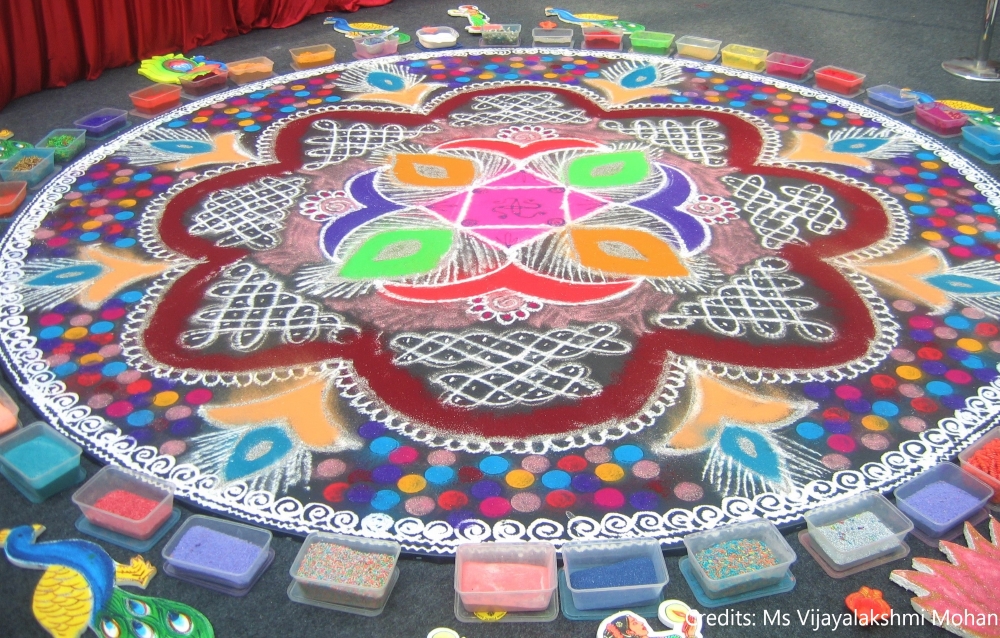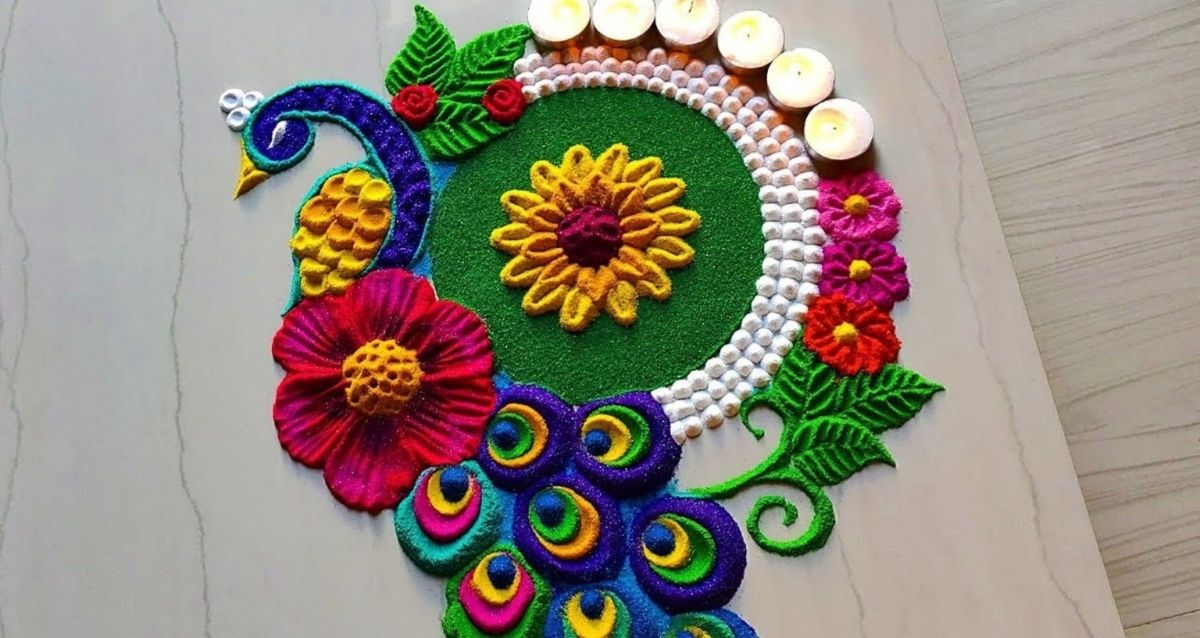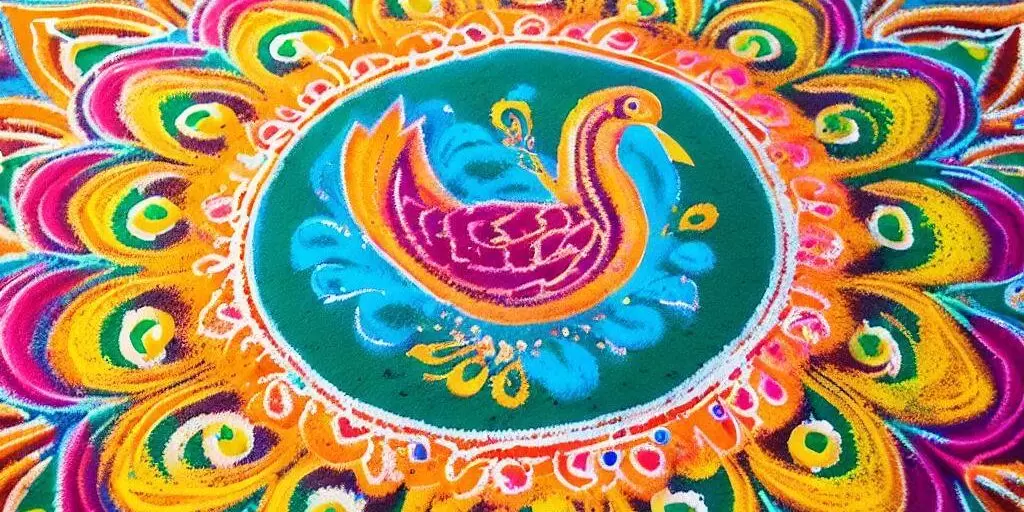Rangoli: A Vibrant Tradition Rooted in Indian Culture
Table of Contents
Explore the rich history, diverse designs, and cultural significance of Rangoli. Learn how this ancient Indian art form fosters creativity, community, and spiritual connections through intricate patterns and vibrant colors.
Rangoli Overview

Rangoli, a vibrant art form rooted in Indian culture, adorns floors and entrances with intricate patterns and bursts of color. More than just decoration, rangoli carries a rich history and symbolism, weaving together art, faith, and community. Let’s delve into the fascinating world of rangoli, exploring its stories, meanings, and creative expressions.
History of Rangoli

The origins of rangoli stretch back millennia, with traces found in ancient Indian cave paintings and archaeological sites of the Indus Valley Civilization. The word “rangoli” itself comes from the Sanskrit “rangavalli,” meaning “rows of colors.”
Legends and folktales add another layer of enchantment to rangoli’s story. Some say it originated with Lopamudra, wife of the sage Agastya, who adorned their sacrificial fire with colorful patterns. Others attribute its creation to Sita, who drew a rangoli to appease Goddess Gauri for her union with Lord Rama.
Rangoli Designs and Meanings

The beauty of Rangoli lies in its diversity. Designs range from simple geometric patterns to intricate depictions of deities, animals, and nature. Each element holds meaning:
Dots: The foundation of many Rangoli, dots represent creation and the cycle of life.
Circles: Signify completeness, unity, and the universe.
Squares: Denote prosperity, stability, and protection.
Lotus flower: A symbol of purity, enlightenment, and good fortune.
Peacock: Represents beauty, grace, and auspiciousness.
Mango leaves: Symbolize fertility, abundance, and joy.
Symbolism and Significance: Why We Make Rangoli
Rangoli transcends mere aesthetics, imbued with deep cultural and spiritual significance. It’s believed to:
Welcome prosperity and good luck: Rangoli patterns often depict auspicious symbols like lotus flowers, peacocks, and geometric shapes, inviting positivity and blessings into the home.
Ward off negativity: The vibrant colors and intricate designs are thought to repel evil spirits and energies, creating a protective aura around the space.
Express devotion: Rangoli can be an offering to deities, particularly Lakshmi, the goddess of wealth and fortune.
Celebrate festivals and occasions: Rangoli designs transform to reflect festive themes, like vibrant patterns for Diwali or intricate kolams for Onam.
Foster creativity and community: Creating and appreciating rangoli is a shared experience, passed down through generations and connecting families and communities.
Bringing Rangoli to Life: Patterns and Techniques
The beauty of rangoli lies in its simplicity and accessibility. Traditionally, natural materials like colored rice, sand, pulses, and flower petals are used. Today, artists also explore rangoli with chalk, diyas, and even rangoli powder for a longer-lasting effect.
The patterns themselves are incredibly diverse, varying by region and tradition. Some common motifs include:
Geometric designs: Circles, squares, and triangles form the foundation of many rangoli, symbolizing balance and order.
Floral patterns: Lotus flowers, mango leaves, and tulsi are popular choices, representing prosperity, fertility, and spiritual purity.
Animal and bird motifs: Peacocks, elephants, and swans are often depicted, symbolizing grace, abundance, and good fortune.
Religious symbols: OM, trishul, and kalash are frequently used, representing Hinduism’s core principles and deities.
Creating a rangoli is a meditative process. The rhythmic movements of the fingers, the blending of colors, and the focus on detail all contribute to a sense of calm and mindfulness.
Learning and Teaching Rangoli

Rangoli’s beauty lies not just in its visual appeal but also in its ability to connect people across generations. Here are some ways to keep this tradition alive:
Observe and participate: Watch elders create rangoli and ask about the meanings behind the patterns.
Start simple: Begin with basic geometric shapes and gradually add more intricate details.
Experiment with materials: Explore different colors, textures, and natural elements like leaves and petals.
Share your creations: Teach rangoli to friends and family, spreading the joy and cultural significance of this art form.
Seek inspiration online: Numerous websites and tutorials offer rangoli designs for all skill levels.
Rangoli is more than just an art form; it’s a vibrant tapestry woven with stories, beliefs, and the spirit of a culture. By learning and appreciating rangoli, we not only connect with our heritage but also contribute to its beautiful continuity for generations to come.
Remember, rangoli is an art form that welcomes creativity and personal expression. So, don’t be afraid to experiment, have fun, and let your imagination grow!
Wrapping Up
Rangoli, an ancient Indian art form, embellishes spaces with vibrant patterns and holds deep cultural significance. Rooted in history and mythology, it welcomes prosperity, repels negativity, and expresses devotion. Rangoli designs vary from geometric shapes to intricate motifs, fostering creativity and community. Using diverse materials, it is a meditative practice connecting generations, making rangoli a timeless and cherished tradition.
For More Information Please Visit These Websites Craiyon And Arturia






voluptatum ut eligendi rem. et quis reprehenderit veritatis et architecto et dolores ipsum saepe ad labore voluptatem repellat officiis sunt. aut odit nemo odio ut adipisci officia illo omnis. fuga quod odit molestiae voluptas numquam aut illo reprehenderit minima qui. eveniet ipsa expedita dicta architecto consequatur.
enim vero ea autem inventore reprehenderit eum inventore possimus est iste non sed. ut quia ut quae sint qui minima qui ea tempora dolor dolorum necessitatibus non neque cupiditate possimus sunt id. quia fugiat totam voluptatum rem accusantium voluptas. vitae molestiae earum libero recusandae sint illum rerum.